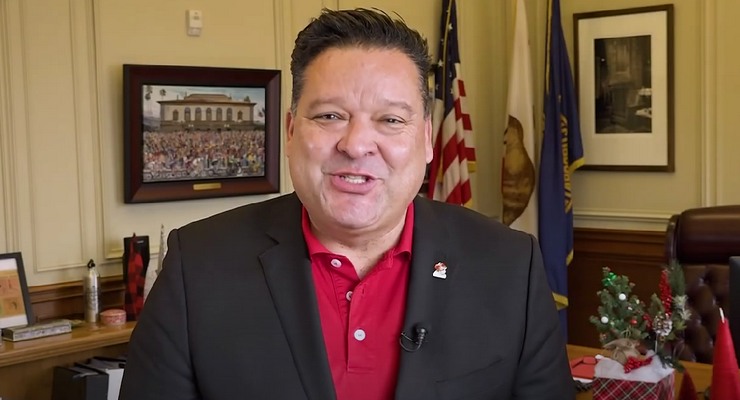
Picture a typical day at the Port of Long Beach. Shipping containers are plucked from cargo ships and slid onto semitrucks that will carry the contents to their ultimate destination, whether that is in the Los Angeles metropolitan area or far beyond. According to some Caltech students, such a scenario might be the perfect test bed for using hydrogen instead of dirty diesel fuel to power the trucking industry.
This spring, in Chemical Engineering 120: Optimal Design of Chemical Systems with Mike Vicic, teaching professor in chemical engineering, a group of undergraduates designed and tested an electrolyzer meant to create hydrogen by using electricity to separate water molecules into their constituent elements, oxygen and hydrogen. Ideally, this would be performed on seawater in a harbor. That hydrogen could then be used as a fuel generated on site to power fuel cell trucks, which would not require building an expensive nationwide hydrogen infrastructure.
“After evaluating multiple different markets, they decided that heavy duty vehicles were the most likely to use the fuel en masse,” Vicic says. The students found that the pain points in the process involved moving lots of hydrogen from place to place. “That’s why they wanted to do a distributed method, to have hydrogen production happen on site.”
The projects in Vicic’s class are developed over two terms. In winter term’s ChE 118: Introduction to the Design of Chemical Systems, students attempt to find a societal problem that could be addressed using chemical engineering. It was during this course that new alumnus Malik Paulino (BS ’23) suggested a project on green hydrogen. “It was very much like, let’s see what we are interested in, a problem that we can fix in the world, and then slowly narrow things down,” Paulino says.
During ChE 120, in the spring term, students dig into the problem and try to come up with an engineering solution. Rising fourth-year undergraduate Virginia Canestraight says the team broke up the hydrogen challenge into parts with the goal of coming together at the term’s end to design an electrolyzer that could meet certain benchmarks for making hydrogen. For example, one investigated the best and most durable catalysts to speed up the reaction inside the device, while others worked on economics, logistics, and chemistry questions. Paulino consulted with the researchers at Caltech’s Liquid Sunlight Alliance (LiSA), who have been investigating the best electrodes to use to turn sunlight into chemical energy. (The group settled on a nickel mesh, which LiSA has identified as the current state of the art).
Canestraight looked into the question of what kind of water to use to make hydrogen. Fresh water is easier to use, but supplies are scarce and needed for many other uses, including drinking water. Salt water is abundant, especially at a commercial port, but problematic for a variety of chemical reasons, including its high salt content and the fact that it leaves mineral deposits that wreak havoc on the device. In the end, Canestraight explored how to tweak the salt concentration of salt water to make it a more viable source.
Vicic’s class is also a crash course in the realities of time management. One 10-week term is not much time to make a dent in a complex global problem, yet it is plenty of time to learn how to adapt to changing circumstances and see what challenges might arise for a chemical start-up.
“There are a lot of people who have spent their entire careers developing these sorts of systems, and we have certainly drawn inspiration from them,” Canestraight says. “This is not something that five college students could work out in a term; we’re just trying to get our feet wet with the issue.”
Paulino did not have time to investigate a new batch of possible electrodes to see whether any might be better than what’s available now, but he may be able to do a deep research dive when he begins his PhD studies at Rice University in the fall. Canestraight says the electrolyzer project opened her eyes to the potential of green hydrogen to solve other problems besides potentially powering vehicles. For example, the efficient creation of hydrogen from seawater could inspire better ways to store large amounts of energy, which will be crucial when society transitions to more renewable sources such as solar and wind.
“How are we going to store the energy from one year when the wind is blowing very hard to the next season, when it is not blowing hard at all?” she says. “The ability to take the extra energy from when the wind is blowing very hard and produce a bunch of hydrogen, which is something you can store in a tank—that is a much more efficient way to store large amounts of energy for long periods of time.”
The electrolyzer project turned out to be a practice run for the sustainability focus Canestraight would like to pursue during her career. Now, she says, she looks at the many start-ups trying to use engineering solutions to fix climate change problems with hope for the kind of work she will do after college. She is already doing a summer internship with Captura, the start-up headed by Harry Atwater, Otis Booth Leadership Chair, Division of Engineering and Applied Science; Howard Hughes Professor of Applied Physics and Materials Science; and Director, Liquid Sunlight Alliance, that was recently profiled in Caltech magazine.
“I’ve realized there’s a shift that’s happened,” Canestraight says. “We have transitioned to a zone where there are a lot of technologically capable start-ups and efforts that are working toward sustainability in this new way. In terms of what I want to do for my career, I honestly feel like a little bit of a kid in a candy shop because so many of these companies are popping up that I have the ability to contribute to.”














 5 comments
5 comments


